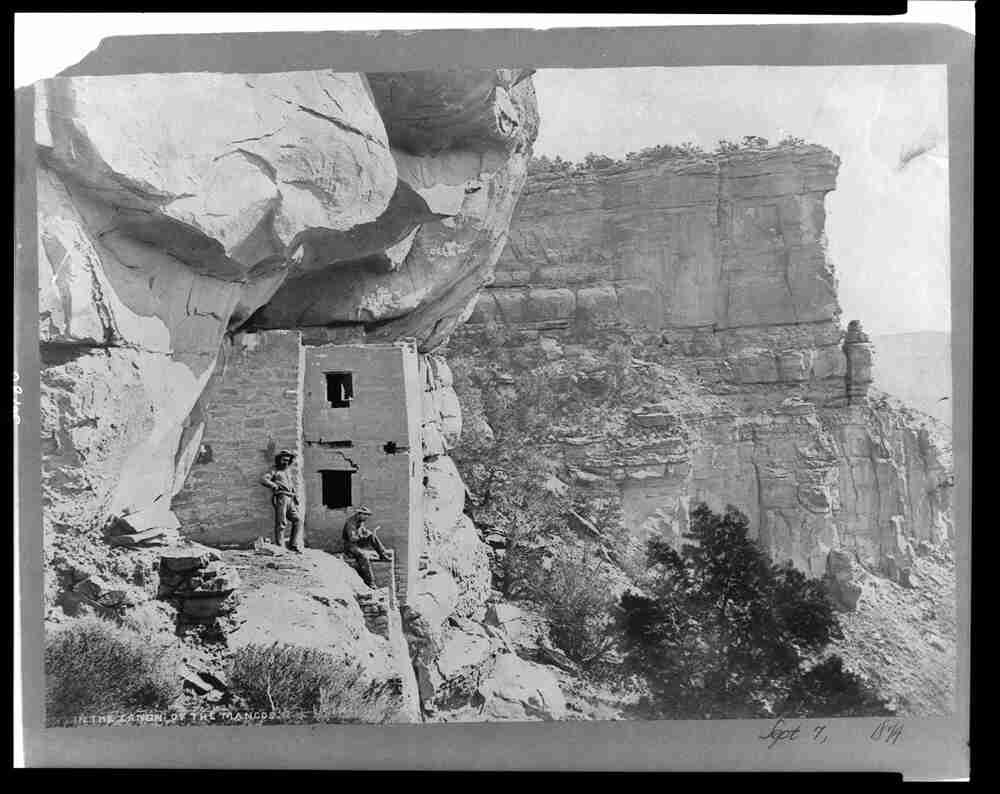Cliff Dwelling
Full Article
The cliff dwellings of southwestern Colorado are among the world’s greatest archaeological treasures. The term cliff dwelling can be applied to any archaeological site used as a habitation and located in an alcove or rock overhang; however, the most famous cliff dwellings are those created by Ancestral Pueblo people during the thirteenth century.
The largest and greatest concentration of cliff dwellings is located in Mesa Verde National Park, but there are numerous others throughout the sandstone canyons of southwestern Colorado, including those found in the Ute Mountain Ute Tribal Park and Canyons of the Ancients National Monument.
Ute, Navajo, and Pueblo peoples knew of the region’s cliff dwellings, and this knowledge is recorded in their oral traditions, but widespread awareness of the cliff dwellings came only after explorers began to regularly visit southwestern Colorado during the mid-to-late nineteenth century.
William H. Holmes and William H. Jackson made the first scientific documentation of a cliff dwelling during the 1874 field season of an expedition known as the Hayden Survey. Jackson described and photographed cliff dwellings in lower Mancos River Canyon at that time.
Perhaps the most important “discovery” of a cliff dwelling occurred in December 1888. Richard Wetherill and Charlie Mason, two ranchers from Mancos, were searching for stray cattle on the landform known as Mesa Verde when they came across an exceptionally large cliff dwelling that, given its size and grandeur, they named “Cliff Palace.”
Of course, the Ute Indians who called Mesa Verde home likely knew about Cliff Palace long before Wetherill and Mason first laid eyes on it, and it is possible that Acowitz—a Ute leader and friend of the Wetherill family—first told them about the ruin and described its general location. It is also likely that Richard’s brother Al viewed Cliff Palace three years earlier in 1885, but he was too tired to enter the alcove and his sighting went unrecorded.
In contrast, Richard Wetherill and a number of other ranchers returned to Cliff Palace to thoroughly explore the ruin in the days that followed their discovery. This triggered an ongoing effort by the Wetherill brothers to investigate Mesa Verde’s other cliff dwellings, and by 1890 they had reportedly searched through 182 dwellings. The artifacts they recovered were publicly displayed, and adventurous tourists began to seek out guided trips to view these remarkable sites.
The most notable of these early visitors was Gustaf Nordenskiöld, a Swedish scientist, who arrived at the Wetherill’s Alamo Ranch in July 1891. He worked with the Wetherills and other laborers throughout that summer to excavate and photograph many cliff dwellings on Mesa Verde. Nordenskiöld taught the Wetherills methods that were more scientific and systematic, and in 1893 he published a book, The Cliff Dwellers of Mesa Verde, that reports on the excavations and the collections he amassed. He removed these artifacts to his homeland, and today the collection is housed at the National Museum of Finland in Helsinki.
The early explorations of cliff dwellings and Nordenskiöld’s removal of artifacts to another country led to the recognition that the cliff dwellings and other archaeological sites needed protection. The result was the Antiquities Act of 1906, which led to the creation of Mesa Verde National Park that year. It was the first park set aside to preserve cultural, as opposed to natural, resources.
The cliff dwellings in southwestern Colorado have provided unparalleled opportunities for research because of the remarkable preservation of the buildings and the artifacts found there. Some structures contain intact roofs made from timbers, other vegetal material, and sediment commonly referred to as adobe. These preserved timbers were key resources in the development of tree-ring dating, the world’s most precise method for dating archaeological sites.
Artifacts recovered from cliff dwellings include durable items such as stone tools and pottery as well as perishable materials such as clothing, sandals, and blankets that are preserved because the alcoves keep the dwellings dry and largely free of moisture. These perishable artifacts are not preserved at other, more open sites, and they have been critical to reconstructing the lives of Ancestral Pueblo people.
Today the cliff dwellings of southwestern Colorado are also among the most important sites for educating the public about Ancestral Pueblo people and the human past. More than half a million people visit the cliff dwellings each year. Most go to Mesa Verde National Park, but many also visit the Ute Mountain Tribal Park and Canyons of the Ancients National Monument.













